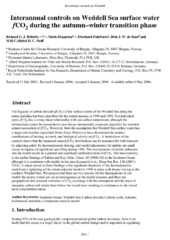Interannual controls on Weddell Sea surface water fCO2 during the autumn–winter transition phase
Peer reviewed, Journal article
Permanent lenke
https://hdl.handle.net/1956/386Utgivelsesdato
2004-06Metadata
Vis full innførselSamlinger
- Geophysical Institute [1198]
Originalversjon
https://doi.org/10.1016/j.dsr.2004.01.002Sammendrag
The fugacity of carbon dioxide (fCO2) of the surface waters of the Weddell Sea along the prime meridian has been described for the austral autumn in 1996 and 1998. For individual years, fCO2 has a strong linear relationship with sea surface temperature, although the relationships cannot be reconciled to provide an interannually consistent algorithm for remotely sensed assessment of fCO2: However, from the assumption that Weddell Sea surface water has a single end member (upwelled Warm Deep Water) we have determined the relative contributions of heating, ice-melt, and biological activity on fCO2: A breakdown of the controls shows that the measured annual fCO2 distributions can be recreated for both transects by adjusting solely for thermodynamic forcing, and model adjustments for salinity are small except in regions of significant upwelling during 1998. The incorporation of nitrate utilisation into the model results in a general and significant underestimation of fCO2: This runs contrary to the earlier findings ofSabine and Key (Mar. Chem. 60 (1998) 95) in the Southern Ocean although it is consistent with models in the area (Louanchi et al., Deep-Sea Res. I 48 (2001) 1581). A major caveat to these findings is the significant departure ofthe thermodynamic model and a tightening ofthe nitrate-adjusted model in 1998 in areas with deeper mixing in the southern Weddell Sea. We propose that there are two reasons for the discrepancies in our model: the source waters are not as homogenous as the model assumes; and there are geographical and seasonal variations ofCO 2 exchange with the atmosphere and the input of inorganic carbon and nitrate from below the mixed layer resulting in imbalances in the mixed layer concentration ratios.
